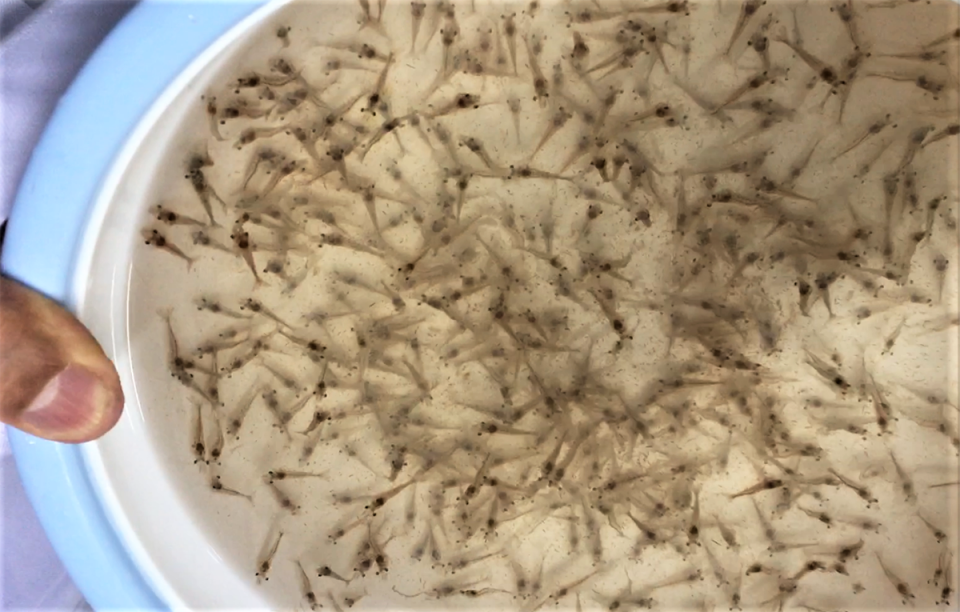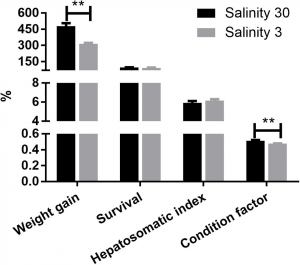At low salinity, shrimp exhibited inhibited growth and different lipid profiles

The Pacific white shrimp (Litopenaeus vannamei) is considered a highly efficient osmoregulatory species [one that can regulate its internal ionic balance] that can tolerate a wide range of salinities from 0.5 to 50 ppt. Aquatic animals require more energy for osmoregulation at low salinity levels, and L. vannamei reportedly needs significant extra energy (20 to 50 percent of total metabolic energy) for osmoregulatory processes including increasing metabolic rate, modification of cellular membrane components, alterations in ion transport enzyme activity, highly unsaturated fatty acids (HUFAs) concentration, free amino acids (FAAs) concentration, water permeability of gills and synthesis of certain non-essential amino acids under low salinity stress
Researchers have shown that increasing dietary lipid level from 6 to 9 percent can alleviate the osmoregulatory pressure of L. vannamei under low-salinity stress. However, information is limited on the physiological functions of specific lipids and fatty acid metabolites in improving osmoregulatory efficiency of shrimp under low salinity conditions.
Lipidomics is a mass spectrometry-based [analytical laboratory technique to separate the components of a sample by their electrical charge and mass] field of science for exploring the structure, composition, and even quantity of lipids in biological systems such as cells, organs and body fluids. In shrimp, the gill is the organ primarily responsible for osmoregulation of hemolymph [a fluid analogous to the blood in vertebrates, and which circulates inside the bodies of insects and crustaceans] and muscle is the material repository or nutrient pool. However, little is known about the lipid responses in either gill or muscle in L. vannamei under low salinity
This article – adapted and summarized from the original publication (Huang, M. et. al., 2019. Growth and Lipidomic Responses of Juvenile Pacific White Shrimp Litopenaeus vannamei to Low Salinity. Front. Physiol. 10:1087) – reports on a study that investigated the significant differences in lipid metabolites between shrimp grown in salinities of 3 and 30 ppt using liquid chromatography-mass spectrometry [an analytical chemistry technique that identifies most organic compounds] analysis.
Study setup
Healthy juvenile L. vannamei juveniles were procured obtained from a shrimp breeding operation in Danzhou (Hainan, China) and acclimatized in the lab for one week at 30 ppt salinity. The acclimated shrimp (0.75 ± 0.03 grams) were then randomly stocked into separate tanks with four replicates for each salinity group (3 and 30 ppt), with 20 animals per tank. During the acclimation and experimental periods, the shrimp were fed three times daily with a commercial feed and daily rations were adjusted to a feeding level slightly more than satiation. The photoperiod was 12 hours of light and 12 hours of dark. Water pH (7.5 to 7.9), temperature (26 to 28 degrees-C), dissolved oxygen (4.8 to 6.4 mg per liter) and total ammonia nitrogen concentration (<0.02 mg per liter) were monitored twice a week and maintained throughout the experiment.
After eight weeks, all shrimp were fasted for 24 hours prior to sampling. Shrimp in each tank were bulk weighed and counted, and hepatopancreas, gills and muscle tissues samples were collected. Hepatopancreases were weighed to determine the hepatosomatic index. Gills and muscles from four individuals in each tank were pooled as one sample and frozen in liquid nitrogen immediately, and then were kept at minus-80 degrees-C for lipidomics analysis.
For detailed information on the experimental design and setup; shrimp husbandry and sample collection; lipid extraction, identification and lab analyses; and statistical analyses, refer to the original publication.
Results and discussion
This is the first investigation examining the effect of low salinity stress on L. vannamei using lipidomics analysis. In our study, L. vannamei juveniles were grown at two different salinities, 3 and 30 ppt (control) for eight weeks, and then a liquid chromatography (LC) mass spectrometry (MS)-based lipidomics analysis was performed to reveal the lipid profile differences in gill and muscle.
Our results showed that L. vannamei shrimp cultured at 30 ppt salinity had better growth than shrimp reared at 3 ppt salinity (Fig. 1). As a euryhaline [capable of adapting to a wide salinity range] species, L. vannamei has been reported by various researchers to have an optimal salinity range of 20 to 25 ppt for growth. Our L. vannamei under low salinity had lower weight gain and condition factor [relationship between body length and weight] than the control shrimp at 30 ppt, but no differences were found in survival and hepatosomatic index [which reflects physiological condition of the animals]. Also, shrimp grown at 3 ppt salinity required more energy than at 30 ppt.

The data from our research indicated that the shrimp having better growth performance at 30 ppt salinity were closer to their hemolymph isotonic point [where there is a balance between the concentration of water inside and outside the animal], and also further confirmed that ambient water at 3 ppt was definitely stressful for L. vannamei.
We determined that the lipid components in gill tissues obtained from our experimental shrimp were very similar to those of muscle, regardless of ambient salinities, and phospholipids were the principal lipids. But a higher number of differential lipid metabolites were identified in gill than in muscle at 3 ppt salinity relative to the control shrimp at 40 ppt salinity; these lipid metabolites belonged to several lipid classes. And of these lipids, phosphatidylcholine (PC), phosphatidylinositol (PI), phosphatidic acid (PA), phosphatidylethanolamine (PE) and triglycerides (TG) were the main lipids in both shrimp gill and muscle, regardless of salinities.
Osmoregulation is an energy-dependent process and aquatic animals are forced to spend more additional energy for modulating and stimulating transport mechanisms for ions [particles, atoms or molecules with a net electrical charge] when challenged with salinity stress. Various researchers have reported oxygen consumption and respiratory quotients [the ratio of carbon dioxide produced by the body to oxygen consumed by the body] as good indicators for assessing the energy utilization; for our shrimp, these indicators at 3 ppt were significantly higher than those of shrimp at 17 and 32 ppt.
Our also data showed that the composition and relative abundance of fatty acids at the same position of the specific lipid class was similar in L. vannamei regardless of ambient salinities or tissues, indicating that the distribution of fatty acids in lipids was far from random, and the utilization of lipid classes is highly specific in L. vannamei. And important fatty acids like eicosapentaenoic acid (EPA) and docosahexaenoic acid (DHA) showed significantly positive genetic correlations, suggesting that their high values have potential for genetic improvement.
Overall, the results of our study show that the lipid variations determined are closely related to several physiological processes (bio-membrane structure, mitochondrial function, energy supply and others) that can improve the osmoregulatory capacity of L. vannamei under low-salinity conditions.
Perspectives
Our results showed that growth performance in L. vannamei is inhibited when the shrimp are grown at a salinity of 3 ppt. The substantial changes in lipid profile we determined were related to fatty acid utilization, energy supply and other processes that can improve the shrimp osmoregulatory capacity. This remarkable change in lipid profile is a significant physiological strategy developed and used by L. vannamei shrimp to cope with low-salinity stress.
This study helps explain the physiological strategies of used by L. vannamei to adapt to low-salinity waters and provides new insights into the significance of lipids for osmoregulation in this species of shrimp.
Now that you've reached the end of the article ...
… please consider supporting GSA’s mission to advance responsible seafood practices through education, advocacy and third-party assurances. The Advocate aims to document the evolution of responsible seafood practices and share the expansive knowledge of our vast network of contributors.
By becoming a Global Seafood Alliance member, you’re ensuring that all of the pre-competitive work we do through member benefits, resources and events can continue. Individual membership costs just $50 a year.
Not a GSA member? Join us.
Authors
-
Maoxian Huang
Key Laboratory of Tropical Biological Resources of Ministry of Education
Hainan University
Haikou, China; and
Department of Aquaculture
College of Marine Sciences
Hainan University
Haikou, China -
Yangfan Dong, Ph.D.
Department of Aquaculture
College of Marine Sciences
Hainan University
Haikou, China -
Yan Zhang, Ph.D.
Department of Aquaculture
College of Marine Sciences
Hainan University
Haikou, China -
Qinsheng Chen, Ph.D.
Department of Aquaculture
College of Marine Sciences
Hainan University
Haikou, China -
Jia Xie, Ph.D.
Department of Aquaculture
College of Marine Sciences
Hainan University
Haikou, China -
Chang Xu, Ph.D.
Department of Aquaculture
College of Marine Sciences
Hainan University
Haikou, China -
Qun Zhao, Ph.D.
Department of Aquaculture
College of Marine Sciences
Hainan University
Haikou, China -
Erchao Li, Ph.D.
Corresponding author
Key Laboratory of Tropical Biological Resources of Ministry of Education
Hainan University
Haikou, China; and
Department of Aquaculture
College of Marine Sciences
Hainan University
Haikou, China[110,99,46,117,100,101,46,117,110,99,101,46,111,105,98,64,105,108,99,101]


